
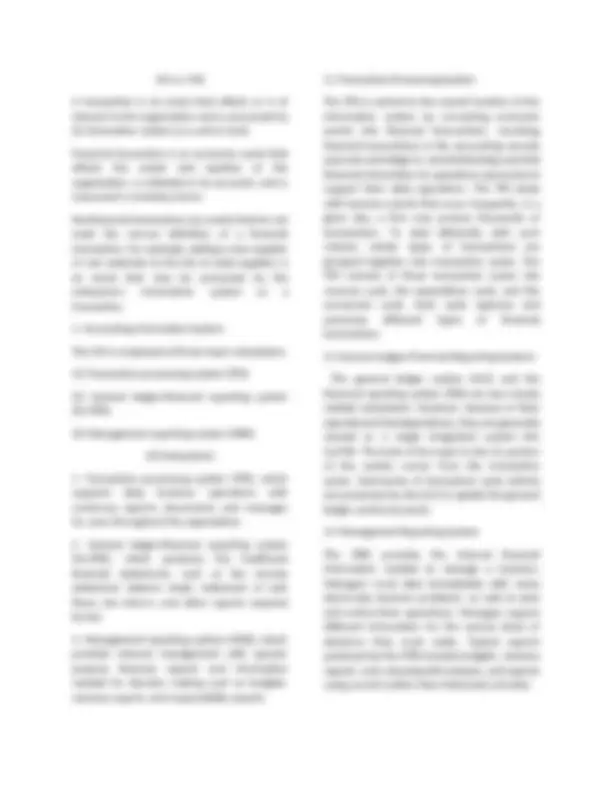
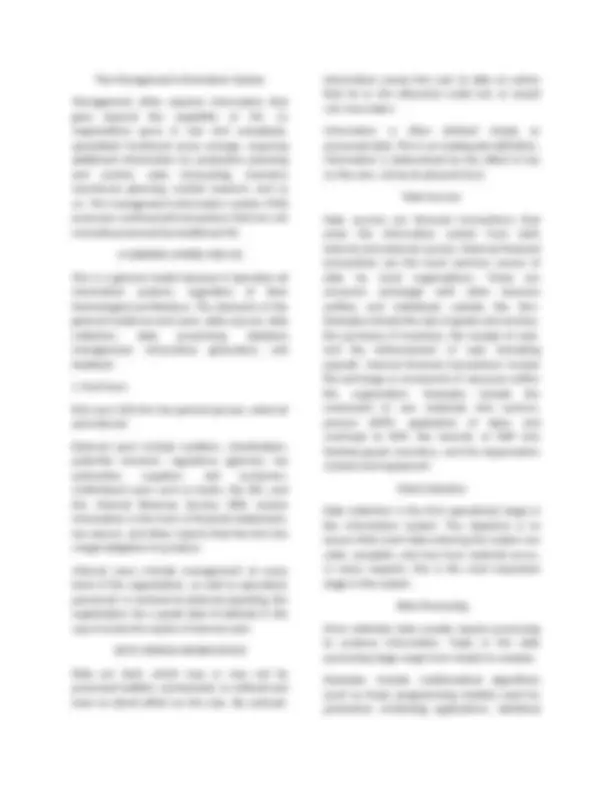
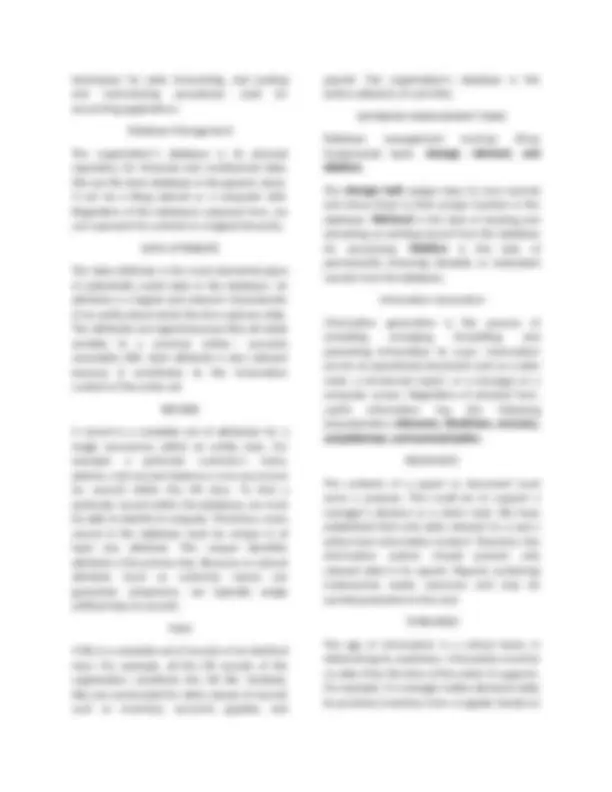
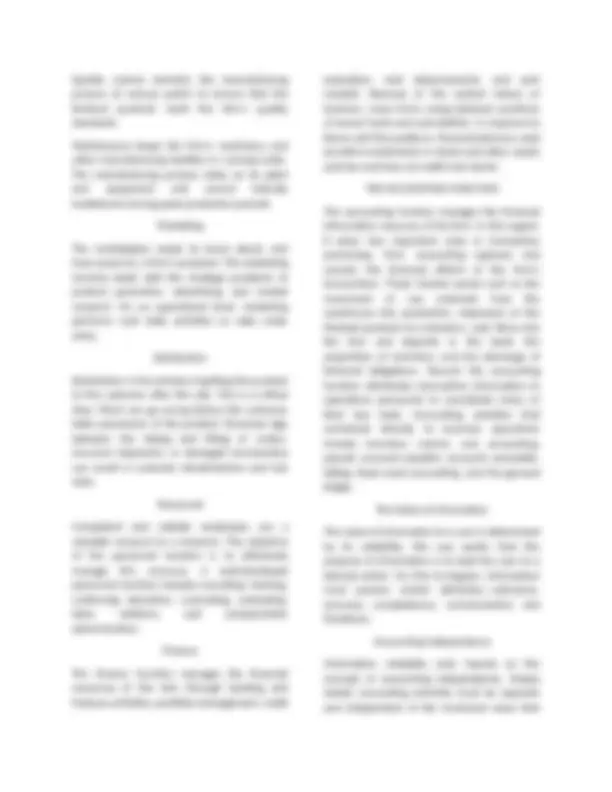
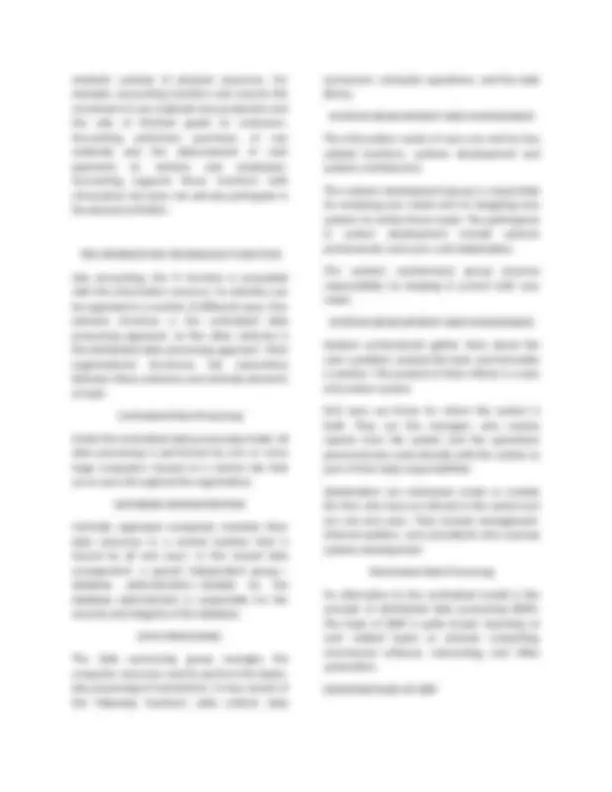
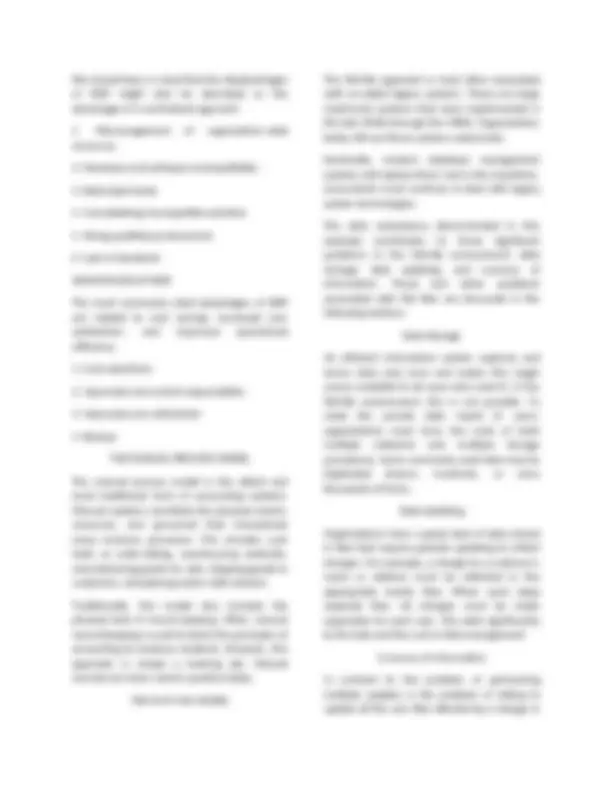


Study with the several resources on Docsity

Earn points by helping other students or get them with a premium plan


Prepare for your exams
Study with the several resources on Docsity

Earn points to download
Earn points by helping other students or get them with a premium plan
Community
Ask the community for help and clear up your study doubts
Discover the best universities in your country according to Docsity users
Free resources
Download our free guides on studying techniques, anxiety management strategies, and thesis advice from Docsity tutors
An overview of Accounting Information Systems (AIS), explaining their role in businesses and the importance of structured data. It discusses the three major subsystems of an AIS: Transaction Processing System (TPS), General Ledger/Financial Reporting System (GL/FRS), and Management Reporting System (MRS).
Typology: Study notes
Uploaded on 10/07/2021
1 document
1 / 12

This page cannot be seen from the preview
Don't miss anything!







Accounting Information System- A STRUCTURE THAT A BUSINESS USES TO COLLECT, STORE, MANAGE, PROCESS, RETRIEVE, AND REPORT ITS FINANCIAL DATA SO IT CAN BE USED BY ACCOUNTANTS, CONSULTANTS, BUSINESS ANALYSTS, MANAGERS, CHIEF FINANCIAL OFFICERS (CFOS), AUDITORS, REGULATORS, AND TAX AGENCIES. AIS People- ACCOUNTANTS, CONSULTANTS, BUSINESS ANALYSTS, MANAGERS, CHIEF FINANCIAL OFFICERS (CFOS), AUDITORS, REGULATORS, AND TAX AGENCIES Components- • PEOPLE • PROCEDURES AND INSTRUCTIONS • DATA • SOFTWARE • IT INFRASTRUCTURE • INTERNAL CONTROL AIS People- THE PEOPLE IN AN AIS ARE THE SYSTEM USERS. PROFESSIONALS WHO MAY NEED TO USE AN ORGANIZATION'S AIS INCLUDE: ACCOUNTANTS CONSULTANTS BUSINESS ANALYSTS MANAGERS CHIEF FINANCIAL OFFICERS AUDITOR Procedures and Instructions- THE METHODS IT USES FOR COLLECTING, STORING, RETRIEVING, AND PROCESSING DATA. THESE METHODS ARE BOTH MANUAL AND AUTOMATED. AIS Data- AN AIS MUST HAVE A DATABASE STRUCTURE TO STORE INFORMATION, SUCH AS STRUCTURED QUERY LANGUAGE (SQL), WHICH IS A COMPUTER LANGUAGE COMMONLY USED FOR DATABASES. THE TYPE OF DATA INCLUDED IN AN AIS DEPENDS ON THE NATURE OF THE BUSINESS, BUT IT MAY CONSIST OF THE FOLLOWING: SALES ORDERS CUSTOMER BILLING STATEMENTS SALES ANALYSIS REPORTS PURCHASE REQUISITIONS VENDOR INVOICES CHECK REGISTERS GENERAL LEDGER INVENTORY DATA PAYROLL INFORMATION TIMEKEEPING TAX INFORMATION AIS Software- **THE SOFTWARE COMPONENT OF AN AIS IS THE COMPUTER PROGRAMS USED TO STORE, RETRIEVE, PROCESS, AND ANALYZE THE COMPANY'S FINANCIAL DATA. BEFORE THERE WERE COMPUTERS, AN AIS WAS A MANUAL, PAPER-BASED SYSTEM, BUT TODAY, MOST COMPANIES ARE USING COMPUTER SOFTWARE AS THE BASIS OF THE AIS. ** QUALITY, RELIABILITY, AND SECURITY ARE KEY COMPONENTS OF EFFECTIVE AIS SOFTWARE IT Infrastructure- THE HARDWARE USED TO OPERATE THE ACCOUNTING INFORMATION SYSTEM. MOST OF THESE HARDWARE ITEMS A BUSINESS WOULD NEED TO HAVE ANYWAY AND CAN INCLUDE THE FOLLOWING: COMPUTERS MOBILE DEVICES SERVERS PRINTERS SURGE PROTECTORS ROUTERS STORAGE MEDIA A BACK-UP POWER SUPPLY Internal Controls- ARE THE SECURITY MEASURES IT CONTAINS TO PROTECT SENSITIVE DATA ● CONTROL ACTIVITIES ARE ACTIONS SUPPORTED BY POLICIES AND PROCEDURES TO MANAGE RISK. ● TYPES: PREVENTATIVE AND DEFECTIVE AN AIS CONTAINS CONFIDENTIAL INFORMATION BELONGING NOT JUST TO THE COMPANY BUT ALSO TO ITS EMPLOYEES AND CUSTOMERS. THIS DATA MAY INCLUDE: SOCIAL SECURITY NUMBERS SALARY AND PERSONNEL INFORMATION CREDIT CARD NUMBERS CUSTOMER INFORMATION COMPANY FINANCIAL DATA FINANCIAL INFORMATION OF SUPPLIERS AND VENDORS ** A WELL-DESIGNED AIS ALLOWS A BUSINESS TO RUN SMOOTHLY ON A DAY-TO-DAY BASIS ** A POORLY DESIGNED AIS CAN HINDER ITS OPERATION. ** USE FOR AN AIS IS THAT, WHEN A BUSINESS IS IN TROUBLE, THE DATA IN ITS AIS CAN BE
Elements of a System Regardless of their origin, all systems possess some common elements. To specify: A system is a group of two or more interrelated components or subsystems that serve a common purpose. Let’s analyze the general definition to gain an understanding of how it applies to businesses and information systems.
The Management Information System Management often requires information that goes beyond the capability of AIS. As organizations grow in size and complexity, specialized functional areas emerge, requiring additional information for production planning and control, sales forecasting, inventory warehouse planning, market research, and so on. The management information system (MIS) processes nonfinancial transactions that are not normally processed by traditional AIS. A GENERAL MODEL FOR AIS This is a general model because it describes all information systems, regardless of their technological architecture. The elements of the general model are end users, data sources, data collection, data processing, database management, information generation, and feedback.
techniques for sales forecasting, and posting and summarizing procedures used for accounting applications. Database Management The organization’s database is its physical repository for financial and nonfinancial data. We use the term database in the generic sense. It can be a filing cabinet or a computer disk. Regardless of the database’s physical form, we can represent its contents in a logical hierarchy. DATA ATTRIBUTE The data attribute is the most elemental piece of potentially useful data in the database. An attribute is a logical and relevant characteristic of an entity about which the firm captures data. The attributes are logical because they all relate sensibly to a common entity— accounts receivable (AR). Each attribute is also relevant because it contributes to the information content of the entire set. RECORD A record is a complete set of attributes for a single occurrence within an entity class. For example, a particular customer’s name, address, and account balance is one occurrence (or record) within the AR class. To find a particular record within the database, we must be able to identify it uniquely. Therefore, every record in the database must be unique in at least one attribute. This unique identifier attribute is the primary key. Because no natural attribute (such as customer name) can guarantee uniqueness, we typically assign artificial keys to records. FILES A file is a complete set of records of an identical class. For example, all the AR records of the organization constitute the AR file. Similarly, files are constructed for other classes of records such as inventory, accounts payable, and payroll. The organization’s database is the entire collection of such files. DATABASE MANAGEMENT TASKS Database management involves three fundamental tasks: storage, retrieval, and deletion. The storage task assigns keys to new records and stores them in their proper location in the database. Retrieval is the task of locating and extracting an existing record from the database for processing. Deletion is the task of permanently removing obsolete or redundant records from the database. Information Generation Information generation is the process of compiling, arranging, formatting, and presenting information to users. Information can be an operational document such as a sales order, a structured report, or a message on a computer screen. Regardless of physical form, useful information has the following characteristics: relevance, timeliness, accuracy, completeness, and summarization. RELEVANCE The contents of a report or document must serve a purpose. This could be to support a manager’s decision or a clerk’s task. We have established that only data relevant to a user’s action have information content. Therefore, the information system should present only relevant data in its reports. Reports containing irrelevancies waste resources and may be counterproductive to the user. TIMELINESS The age of information is a critical factor in determining its usefulness. Information must be no older than the time of the action it supports. For example, if a manager makes decisions daily to purchase inventory from a supplier based on
rather than develop in-house. Under this approach, the software vendor designs, implements, and maintains the system for its client. This is a popular option with health care and legal services organizations that have complex systems requirements but are not of sufficient magnitude to justify retaining an in- house systems development staff. Organizational Structure The structure of an organization reflects the distribution of responsibility, authority, and accountability throughout the organization. Firms achieve their overall objectives by establishing measurable financial goals for their operational units. BUSINESS SEGMENTS Business organizations consist of functional units or segments. Firms organize into segments to promote internal efficiencies through the specialization of labor and costeffective resource allocations. Managers within a segment can focus their attention on narrow areas of responsibility to achieve higher levels of operating efficiency. BUSINESS SEGMENTATION
Quality control monitors the manufacturing process at various points to ensure that the finished products meet the firm’s quality standards. Maintenance keeps the firm’s machinery and other manufacturing facilities in running order. The manufacturing process relies on its plant and equipment and cannot tolerate breakdowns during peak production periods. Marketing The marketplace needs to know about, and have access to, a firm’s products. The marketing function deals with the strategic problems of product promotion, advertising, and market research. On an operational level, marketing performs such daily activities as sales order entry. Distribution Distribution is the activity of getting the product to the customer after the sale. This is a critical step. Much can go wrong before the customer takes possession of the product. Excessive lags between the taking and filling of orders, incorrect shipments, or damaged merchandise can result in customer dissatisfaction and lost sales. Personnel Competent and reliable employees are a valuable resource to a business. The objective of the personnel function is to effectively manage this resource. A well-developed personnel function includes recruiting, training, continuing education, counseling, evaluating, labor relations, and compensation administration. Finance The finance function manages the financial resources of the firm through banking and treasury activities, portfolio management, credit evaluation, cash disbursements, and cash receipts. Because of the cyclical nature of business, many firms swing between positions of excess funds and cash deficits. In response to these cash flow patterns, financial planners seek lucrative investments in stocks and other assets and low-cost lines of credit from banks. THE ACCOUNTING FUNCTION The accounting function manages the financial information resource of the firm. In this regard, it plays two important roles in transaction processing. First, accounting captures and records the financial effects of the firm’s transactions. These include events such as the movement of raw materials from the warehouse into production, shipments of the finished products to customers, cash flows into the firm and deposits in the bank, the acquisition of inventory, and the discharge of financial obligations. Second, the accounting function distributes transaction information to operations personnel to coordinate many of their key tasks. Accounting activities that contribute directly to business operations include inventory control, cost accounting, payroll, accounts payable, accounts receivable, billing, fixed asset accounting, and the general ledger. The Value of Information The value of information to a user is determined by its reliability. We saw earlier that the purpose of information is to lead the user to a desired action. For this to happen, information must possess certain attributes—relevance, accuracy, completeness, summarization, and timeliness. Accounting Independence Information reliability rests heavily on the concept of accounting independence. Simply stated, accounting activities must be separate and independent of the functional areas that
We should bear in mind that the disadvantages of DDP might also be described as the advantages of a centralized approach.
status. If update information is not properly disseminated, the change will not be reflected in some users’ data, resulting in decisions based on outdated information. Currency of Information In contrast to the problem of performing multiple updates is the problem of failing to update all the user files affected by a change in status. If update information is not properly disseminated, the change will not be reflected in some users’ data, resulting in decisions based on outdated information. Flat Files Limit Data Integration The flat-file approach is a single-view model. Files are structured, formatted, and arranged to suit the specific needs of the owner or primary user of the data. Such structuring, however, may exclude data attributes that are useful to other users, thus preventing successful integration of data across the organization. For example, because the accounting function is the primary user of accounting data, these data are often captured, formatted, and stored to accommodate financial reporting and generally accepted accounting principles. THE DATABASE MODEL An organization can overcome the problems associated with flat files by implementing the database model to data management. With the organization’s data in a central location, all users have access to the data they need to achieve their respective objectives. Access to the data resource is controlled by a database management system (DBMS). The DBMS is a special software system that is programmed to know which data elements each user is authorized to access. The user’s program sends requests for data to the DBMS, which validates and authorizes access to the database in accordance with the user’s level of authority. THE REA MODEL REA is an accounting framework for modeling an organization’s critical resources, events, and agents (REA) and the relationships between them. Once specified, both accounting and nonaccounting data about these phenomena can be identified, captured, and stored in a relational database. Resources Economic resources are the assets of the organization. They are defined as objects that are both scarce and under the control of the enterprise. This definition departs from the traditional model because it does not include AR. An account receivable is an artifact record used simply to store and transmit data. Events Economic events are phenomena that affect changes in resources. They can result from activities such as production, exchange, consumption, and distribution. Economic events are the critical information elements of the accounting system and should be captured in a highly detailed form to provide a rich database. Agents Economic agents are individuals and departments that participate in an economic event. They are parties both inside and outside the organization with discretionary power to use or dispose of economic resources. Examples of agents include sale clerks, production workers, shipping clerks, customers, and vendors. The REA model requires that accounting phenomena be characterized in a manner consistent with the development of multiple user views. ENTERPRISE RESOURCE PLANNING SYSTEMS